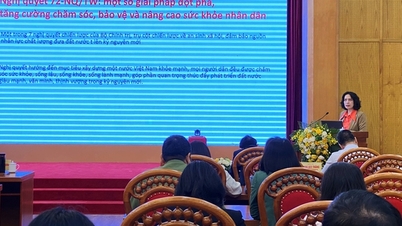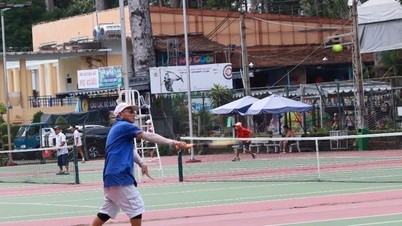
A heart rate below 50 beats/minute will cause a serious reduction in the amount of blood supplying the body - Photo: BVCC
Cases of heart rate that are too slow and appear suddenly can cause cerebral ischemia, leading to confusion, near-fainting or fainting, heart failure, cardiac arrest...
Continuous fainting for many years, critical... but no disease detected
For many years, Ms. NTL (49 years old, Cu Chi, Ho Chi Minh City) has often been in a state of fatigue, sometimes dizzy, nervous, and suddenly fainted. The frequency of fainting gradually increased, and there was even a time when she had to stop on the side of the road while driving and call relatives for help because she suddenly felt dizzy and fainted.
She had gone to many places for health check-ups but only received the conclusion that she had cerebral anemia. Recently, in the middle of the night, she suddenly had difficulty breathing, severe chest pain and fainted. Her family rushed her to Xuyen A General Hospital for emergency treatment.
All basic paraclinical results such as electrocardiogram, brain MRI... at the time of examination did not show any obvious abnormalities. Suspecting sudden fainting spells due to arrhythmia, the doctors ordered the patient to undergo a 24-hour Holter ECG - a compact device that records all electrical activity of the heart continuously day and night.
When reading the results, doctors discovered that the patient had many cardiac arrests, including one lasting more than 18 seconds - something that cannot be detected by a conventional electrocardiogram. This is a manifestation of dangerous bradycardia, a condition that can cause sudden death if not treated promptly.
Similarly, Bac Giang General Hospital has also recently successfully placed permanent pacemakers in two elderly patients with dangerously slow heart rates.
The first case is a female patient named Hoang Thi N. (69 years old, in Huu Lung, Lang Son ) with symptoms of dizziness, prolonged fatigue, and declining health even when walking. When admitted to the hospital, the patient's heart rate was only 40 beats/minute.
The second case is a male patient named Truong Minh L. (65 years old, in Lang Giang, Bac Giang) who often has a feeling of anxiety and palpitations. The results of 24-hour electrocardiogram monitoring using a holter electrocardiogram device showed that there were times when the patient's heart rate slowed to only 35 beats/minute, and at the same time, atrial fibrillation appeared - the main cause of the symptoms of anxiety and palpitations. The diagnosis showed that the sinus node - the heart's natural pacemaker - was severely weakened.
Dr. Nguyen Van Long - Head of the Department of Cardiology, Bac Giang General Hospital - said: "A very slow heart rate due to blockage of the conduction pathways in the heart (complete atrioventricular block) or sinus node failure are dangerous diseases. If not detected and treated promptly, the patient may experience fainting, heart failure, and even be life-threatening."

A heart surgery - Photo: BVCC
Bradycardia - a silent danger after fainting spells that can easily lead to sudden death
Dr. Dinh Minh Tri, Vietnam Cardiovascular Association, said that the heart rate in a normal person is a regular sinus rhythm, the heart rate depends on age and level of physical activity. In adults, the average heart rate is 60-100 times/minute.
When the heart beats slower than 60 times/minute, it may be bradycardia. Bradycardia can occur in anyone but is more common in the elderly. Children and infants rarely experience this condition because the younger they are, the higher the normal heart rate, from
120-160 times/minute. Depending on age, there will be different ranges of normal heart rate, fast, slow.
Dr. Tri analyzed the heart rate range of healthy adults from 60-100 beats per minute. But when suffering from bradycardia, meaning the heart rate is below 60 beats/minute and accompanied by abnormal symptoms.
In healthy people who are physically active, bradycardia is usually benign, but if this condition persists along with other symptoms, you should see a doctor for examination and appropriate treatment. In some cases such as healthy young people, athletes, etc., this condition is not worrisome.
Physiological bradycardia can occur in some people who exercise a lot, such as professional athletes, and does not affect daily activities.
Pathological bradycardia can be caused by cardiovascular diseases such as congenital genetic diseases, sinus node dysfunction, ischemic heart disease, infective endocarditis, myocarditis.
Sometimes this condition is not caused by cardiovascular disease such as hypothyroidism, severe kidney failure, hyperkalemia... Sometimes the slow heart rate is caused by the use of certain medications.
In most cases, bradycardia has no warning symptoms and is only discovered by chance during a health check. Some people have signs such as shortness of breath, chest pain, dizziness, fatigue, difficulty concentrating, and fatigue during heavy exercise.
However, cases of heart rate that are too slow and appear suddenly can cause cerebral ischemia, leading to serious consequences such as confusion, near-fainting or fainting, cardiac arrest. Patients need to be hospitalized immediately to find the cause.
Cardiologist Pham Thanh Binh said that bradyarrhythmia can progress silently but carries a high risk of sudden death if not detected and treated promptly. Diagnosis of arrhythmia is often based on an electrocardiogram or 24-hour holter monitor and the most effective treatment in many cases is to place a permanent pacemaker, helping to maintain a stable and safe heart rate for the patient.
How to prevent bradycardia
Exercise regularly. Eat a healthy diet, low in fat, salt, and sugar. Maintain a healthy weight because being overweight or obese increases the risk of developing heart disease. Eat plenty of fruits, vegetables, whole grains, and fish. Limit fast food, pickles, and fatty foods. Manage your emotions and reduce stress. Get medical checkups. Take medication as prescribed by your doctor.
Is a slow heart rate dangerous?
In clinical practice, bradycardia is usually defined as a resting heart rate below 60 beats/minute in adults. However, bradycardia alone is not sufficient to conclude a pathological condition. The context, accompanying symptoms and underlying pathological cause determine the significance of bradycardia.
Understand bradycardia correctly
People who regularly engage in high-intensity exercise or sleep can have a low heart rate and still be completely healthy. On the contrary, a slow heart rate accompanied by dizziness, fainting, low blood pressure or chest pain are warning signs that require medical examination.
Slow heart rate will reduce the amount of blood pumped by the heart to nourish the body. In people with coronary artery disease or heart failure, too slow heart rate can aggravate myocardial ischemia or cause pulmonary edema. If there are signs of low blood pressure, chest pain, acute shortness of breath or change in consciousness, these are all cardiovascular emergencies that require immediate medical intervention.
Is bradycardia dangerous?
Not all bradycardias are dangerous. Most bradycardias are physiological and do not require treatment. The danger is when the bradycardia is accompanied by symptoms of hypoperfusion (syncope or presyncope, hypotension, chest pain, dyspnea, confusion, transient blindness) or when it is a high-grade or complete acquired atrioventricular block with no reversible cause. This group is at risk of cardiac arrest and often requires permanent pacemaker implantation.
If bradycardia is suspected, how should it be monitored?
Self-monitor your pulse and blood pressure once or twice a day during the symptomatic period. Keep a diary of the time, the activity you are doing, and any accompanying symptoms (lightheadedness, fainting, chest pain, shortness of breath). Wearable devices (smartwatches, wrist blood pressure monitors) can be useful for identifying heart rate trends, but diagnosis still relies on an electrocardiogram (ECG).
When to see a doctor early: heart rate <50 beats/minute for a long time with fatigue, dizziness; any fainting spell; new bradycardia after taking cardiovascular medication; bradycardia with chest pain, shortness of breath, low blood pressure.
What to pay attention to when living and exercising?
If the baseline heart rate is slow, avoid situations that overstimulate the vagus nerve if symptoms are present. For example, straining, lifting weights while holding your breath, massaging the neck, wearing a tight collar. Maintain soft bowel movements to reduce Valsalva pressure. Control underlying conditions that aggravate the bradycardia.
Regarding physical training: Physiological bradycardia in well-trained and asymptomatic individuals is allowed to exercise normally; priority is given to gradually increasing intensity, with adequate warm-up and recovery time.
Bradycardia or conduction abnormalities with symptoms of hypoperfusion, unproven second- or third-degree AV block, moderate-to-heavy exercise should be postponed until investigation is completed and treatment is optimized. After pacemaker placement: avoid exercise for 1-2 weeks.
MSc. NGO THANH HUNG
(University of Health Sciences, Vietnam National University, Ho Chi Minh City)
Source: https://tuoitre.vn/ngat-dot-ngot-coi-chung-nhip-tim-cham-20251111234350174.htm




![[Photo] Prime Minister Pham Minh Chinh attends a conference to review one year of deploying forces to participate in protecting security and order at the grassroots level.](https://vphoto.vietnam.vn/thumb/1200x675/vietnam/resource/IMAGE/2025/11/12/1762957553775_dsc-2379-jpg.webp)
![[Photo] Highways passing through Dong Nai](https://vphoto.vietnam.vn/thumb/1200x675/vietnam/resource/IMAGE/2025/11/12/1762940149627_ndo_br_1-resize-5756-jpg.webp)






























































































![Dong Nai OCOP transition: [Article 3] Linking tourism with OCOP product consumption](https://vphoto.vietnam.vn/thumb/402x226/vietnam/resource/IMAGE/2025/11/10/1762739199309_1324-2740-7_n-162543_981.jpeg)







Comment (0)